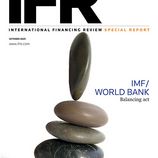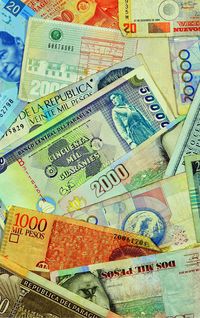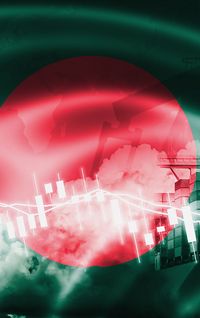The IMF and World Bank have done a good job in aiding African nations during the pandemic, but those countries' governments must now take it upon themselves to act responsibly
The International Monetary Fund and the World Bank made a spirited effort to help African countries weather the Covid-19-induced economic storm this year but wholesale debt relief is now necessary and African governments must learn not to take on too much debt in the future.
Up to 40 Sub-Saharan African countries requested emergency financial assistance from the IMF totalling close to US$16bn this year. Of this amount, as of September 17, the Fund had disbursed US$14.5bn to 30 countries. Furthermore, the IMF is providing relief on debt service payments on its own debt for 21 SSA nations to the tune of US$208m through to October this year.
Both South Africa and Nigeria have for the first time in their recent histories received support under the IMF’s Rapid Financing Instrument (RFI): South Africa to the tune of US$4.3bn and Nigeria US$3.4bn. The RFI provides emergency assistance to all member countries facing an urgent balance of payments issue, including those arising from commodity price shocks. In March, the Fund also approved a US$2.8bn RFI to Egypt and, at the end of June, it agreed to a further US$5.2bn 12-month standby arrangement for that country.
Meanwhile, the World Bank is helping African countries strengthen their pandemic response and healthcare systems. It has approved almost US$1.5bn for the immediate response to the pandemic in 43 African nations, through a combination of new operations and redeployment of existing resources.
Furthermore, more than 20 SSA countries have requested development policy operations or budget support from the bank to help them to manage the pandemic’s fiscal impact. It is also promoting reforms that should create the conditions for economic recovery. As of 25 August, it had approved 17 Covid-19-specific development policy operations in SSA in the order of US$2.9bn, of which US$2.6bn was provided by the International Development Association, the part of the World Bank that helps the world's poorest countries, and US$265m by the International Bank for Reconstruction and Development, the World Bank’s lending arm.
“The IMF has moved swiftly to support governments in Sub-Saharan Africa so they can act to cushion the blow to the most vulnerable people and sectors affected by the pandemic,” said Abebe Aemro Selassie, the director of the IMF’s African Department. “As important as support from the fund and international partners has been – along with quick actions in countries to contain the impact of the pandemic – countries in the region have a long road ahead of them.
“The pandemic is both a public health crisis and an economic crisis, so one takeaway is that our analysis and assessment of risks can benefit from working together with experts from other disciplines to broaden the field of view. Looking ahead to recovery: this is an opportunity to reorient economies – a once-in-a-century shot to build forward better. That means considering how countries invest in building fairer and more equitable, greener and more sustainable, and smarter and digital economies.”
The IMF is forecasting that the SSA economy will contract by 3.2% this year and rebound by 3.4% next year as the rest of the world recovers. It says this outlook is surrounded by lots of uncertainty, with the balance of risks tilted to the downside and related to the evolution of the pandemic.
In April, the IMF and the World Bank spearheaded one of the most important debt relief programmes – known as the Debt Service Suspension Initiative (DSSI). The G20 took up this initiative and agreed to freeze bilateral government loan repayments for 76 low-income countries – including many located in Africa – until the end of the year and called on private sector creditors to participate on a voluntary basis. The debt standstills are designed to be net-present-value neutral.
The International Institute of Finance, a global association of financial institutions, has drawn up a framework to help private sector creditors provide debt service relief on broadly comparable terms as the official sector. However, as of mid-September, there had been little progress on this front.
SUSPICIOUS MINDS
“There are mixed feelings about the World Bank and the IMF support on the African continent,” said Nicky Weimar, group chief economist at Nedbank, the South African banking group. “Many African countries – particularly South Africa – view IMF assistance with great suspicion. Much of this scepticism is based on the experiences of many African and South American countries during the '80s and the '90s. IMF assistance came with strict conditionality – including fiscal and economic reforms – which was often associated with deep recessions or stagnation, while state debt burdens remained high and debt service costs became crippling. However, both the World Bank and IMF have evolved since then.”
The issue for many African nations is the high level of public debt built up again since they enjoyed US$100bn of debt relief under the Heavily Indebted Poor Countries Initiative (HIPC) and the related Multilateral Debt Relief Initiative (MDRI) during the past 25 years. Hard figures for African debt – especially that owed to China – are hard to obtain but SSA had total external debt of US$583bn at the end of 2018, according to the World Bank. China is believed to account for the biggest slice of Africa’s external debt at US$152bn, according to the China Africa Research Initiative team at Johns Hopkins University.
One of the biggest transformations has been the nature of the debt that African nations have taken on. Until 2010, it mostly took the form of bilateral or multilateral credit but, since that time, many sovereigns have assumed commercial debt with a wide universe of private sector creditors, including commercial banks, asset owners and managers, commodity brokers, export credit agencies, sovereign wealth funds, hedge funds and non-financial companies. In April, for example, 21 African countries had outstanding foreign currency debt obligations in the form of Eurobonds of roughly US$115bn, according to Moody’s.
The big question mark hanging over many SSA nations is how they can service their public debt in the wake of the pandemic and the resulting economic meltdown. Most sovereigns are current on their debt obligations but the debt servicing costs have started to gobble up an increasingly painful proportion of the countries’ taxation revenues. On average, the interest payments-to-revenue ratio in SSA jumped to about 10% in 2018 from 5% in 2010, according to the IMF. For oil exporters, it surged fourfold during that period. Worryingly, Nigeria, Ghana and Angola today dedicate more than 40% of government revenue to interest payments. Zambia and Kenya are not far behind.
“SSA countries are not experiencing a wholesale foreign debt problem yet,” said Stuart Culverhouse, head of sovereign and fixed income research at Tellimer, the London-based investment research house. “However, it is true that the collapse in their GDPs this year could make debt servicing a much bigger challenge. The countries’ capacity to pay, their governments sheer willingness to pay could come into question during the next couple of years. Maybe something positive that will come out of this year’s crisis is that creditors in future will monitor more carefully how loans are spent, there will be greater transparency. However, there is then the issue of China, which is becoming a much more important creditor but does not put any emphasis on transparency.
“It is also true that many African government do not consider any vulnerabilities that their economies could have in the future when they assume debt obligations, their debt management strategies do not include enough contingency planning.”
MATURITY SPIKE
Some economists argue that African sovereigns should be able to remain current on their public debt as long as they can improve tax collection. However, a spike in African Eurobond maturities in 2024 and 2025 could overwhelm their ability to refinance their bonds, especially if sentiment towards emerging markets is weak during the next few years.
“In many SSA countries, the problem is not so much one of too much debt but of too low government revenues,” said David Cowan, the chief economist for Africa at Citigroup. “For example, in Nigeria this year, government revenues are going to fall by around one-third compared to 2019, partly because of the economic downturn and partly because of the decline in oil prices. This is a question of political will, whether the governments are willing to mobilise higher taxation revenues. Rwanda continues to pioneer innovative ways to raise revenues. For example, the country is pushing the use of debit cards for purchases, making it easier to collect taxes. Other African countries could make a similar attempt.
“We may well see China strike a series of bilateral deals with SSA sovereigns that involve the rescheduling of their debts. If that happens, a number of debt holders could follow suit. If Zambia defaults on its Eurobond debt – or reaches a voluntary agreement with its creditors – there could be mounting public pressure on the owners of Eurobond debt more generally, on institutional investors in the West, to grant debt relief to African nations.”
Following steep increases in the 1980s and the '90s, the HIPC and MDRI initiatives – combined with other factors – sharply reduced SSA’s debt levels from a peak of about 100% of GDP in the early 2000s to 35% of GDP in the early 2010s. Then, public debt started rising again, reaching an average of about 58% of GDP in 2019, according to the IMF. About half of the countries in SSA have seen their debt stocks double – and in some instances more than triple – since 2009. The fund expects the simple average public debt level for SSA nations to jump temporarily to 64% of GDP in 2020.
The IMF classifies almost half of all Sub-Saharan African sovereigns as being in debt distress or being at high risk of debt distress. The list includes prolific issuers such as Ghana, Ethiopia, Zambia and Kenya.
Other commentators are not so optimistic and believe that what African nations need is debt relief, not debt standstills.
“The key problem has been that the international development community is treating the current financial crisis as one of liquidity,” says Moritz Kraemer, chief economic advisor at Acreditus Partners, a tech and Islamic economy start-up advisory firm. “In fact, many poor countries face a solvency issue and will require debt relief, sometimes significantly so. Getting additional loans, no matter how concessional, will not solve their predicament beyond the very short term. The fund, in particular, needs to take some leadership on the question of debt relief. It seems reluctant to push this agenda, coming so soon after the previous initiative (HIPC) to reduce poor countries’ debt. But outside the non-governmental sector, I can see no other actor that could credibly prepare the argument for more decisive action.”
CURVE IMPLICATIONS
A major consideration for African finance ministers is what impact debt relief would have on their sovereign bond yield curves and on the yield curves of corporate borrowers from their countries. One of the most positive developments in the continent during the past decade has been the creation of sovereign yield curves, which have also enabled private sector companies to come to the market for the first time. Sovereigns run the risk of being punished by existing creditors, prospective investors and ratings agencies if they seek a debt moratorium. Any sovereign downgrades by ratings agencies could make the cost of financing more expensive for private sector companies as well.
“Private sector participation in DSSI efforts is required,” said Kraemer. “About two-thirds of SSA sovereign debt service goes to private creditors. Bondholders, in particular, have been successful in stalling any initiative to include private creditors by scaring African governments, as rescheduling countries could lose market access for years to come, jeopardising their developmental aspirations. History shows, however, that sovereigns can regain market access pretty swiftly.”
One of the main lessons to draw from the current crisis is that the concept of debt sustainability is a tricky one and may work well when economic conditions are relatively stable and where economic indicators move relatively smoothly and predictably. However, it is exactly in those circumstances that a debt sustainability analysis is least important. The tool is not really made for extreme situations like the current one. There is a strong tendency among African governments to think that everything will come right in the end, but really they should show more responsibility when they assume debt. Ultimately, it is not normally the country’s elite that suffers when debt distress happens, it is the people at large.
“I think the number of African countries that require more than liquidity support, that need a debt writedown runs into the double digits,” said Masood Ahmed, president of Center for Global Development, a Washington DC-based think tank.
“It will take a number of years for African countries to recover economically from this crisis, it’s not a quick recovery scenario. Covid-19 and the lockdowns have set back their economies for years to come. Furthermore, developing world governments now have a broader and more costly policy agenda, they must deal with public health and children-out-of-school issues.
“The debt burden problem will come to a head next year. There is a long gap between a debt issue becoming clear and the creditors accepting it. The IMF and the World Bank must start working on a framework and a set of principles for how the writedowns can work in practice.”
NO EASY FIX
The IMF says it is clear that achieving a resilient recovery in Sub-Saharan Africa will not be easy. Kristalina Georgieva, the IMF’s managing director, and Abebe Aemro Selassie wrote on a recent blog: “For one, it will be expensive. Precisely estimating the costs is not easy given complementarities between investments in people, infrastructure and policies. But it will certainly be in the hundreds of billions of dollars in the coming years. Meanwhile, of course, the Covid-19 crisis is taking a toll on the region’s already limited fiscal space. And, even before the crisis, most countries’ public debts were increasing rapidly.
“Second, it will require transformative reforms. Important as external support will be, it will be neither effective nor sufficient unless policy-induced distortions that stymie private investment are eliminated or public finance management systems improve. More domestic revenue mobilisation will also be imperative – something which digitalisation can help by improving the efficiency of collection.
“Third, support from the international community will be vital. Stepped-up debt relief, financing and capacity development will all be needed. The IMF is supporting the recovery in Sub-Saharan Africa through all three of those channels. And we certainly will be doing more in the years ahead.”
Perhaps the IMF’s current engagement with Nigeria and South Africa will lead to substantive structural reform in Africa’s two biggest economies, something that many economist have been hoping for for a long time. However, not everyone is convinced.
“I think there is very little chance of Nigeria signing up to a formal IMF programme while President Buhari is in office,” said Citigroup’s Cowan. “The only chance of this happening is if the oil price does not recover. In South Africa’s case, this is the first time the country has accepted a big loan from the IMF in the post-apartheid era. In the past, the idea of doing so generated considerable angst among the general public but President Ramaphosa appears to have surmounted that hurdle. This could make it easier if the country were to enter a formal programme in the future.
"A programme in Nigeria would entail the government having to further liberalise the naira; that would be a painful thing for government to do. On the other hand, the South African government would not have that problem as the rand is freely floating.”
Improved coordination between creditors is one key takeaway from this emergency. In the 1980s’ debt crisis, the number of official and private creditors was relatively limited. Coordination was not easy then but easier than today, as the number of creditors with disparate objectives and perspectives has mushroomed.
“The World Bank and IMF have done a tremendous job in trying to cushion African countries against the huge shock the economies would have faced,” said Murega Mungai, Nairobi-based trading desk manager at AZA, a non-bank currency broker. “They have done what they could within their capacities and it now comes down to individual governments to overcome the effects of the pandemic.”
The two institutions will have to coordinate a wholesale debt relief programme in Africa during the next few years. Someone needs to lead from the front and no other agencies exist that could play that role better than the IMF and the World Bank.
However, the plain truth is that – once again – too many African governments have assumed too much debt and debt service is starting to overwhelm their fragile economies. African governments must be more prudent in the future and appreciate that a debt burden can easily spiral out of control.
To see the digital version of this report, please click here
To purchase printed copies or a PDF of this report, please email gloria.balbastro@refinitiv.com




























